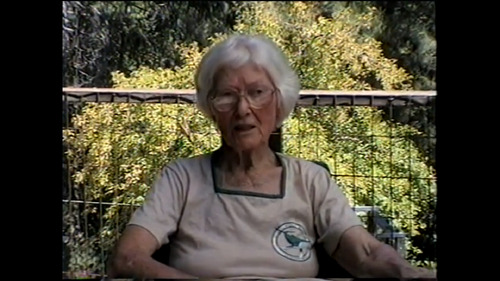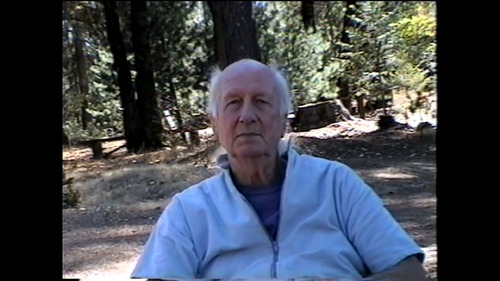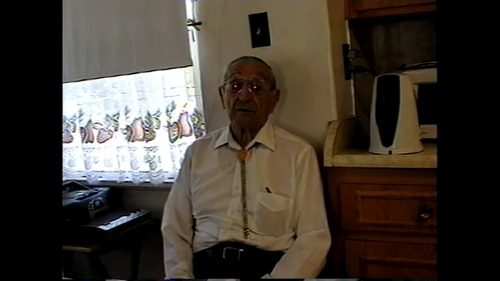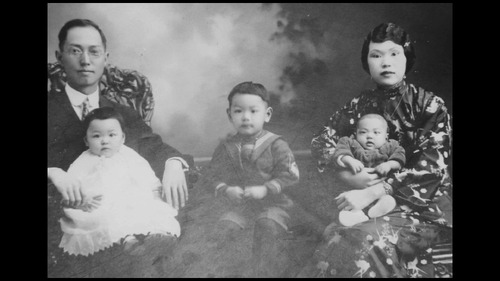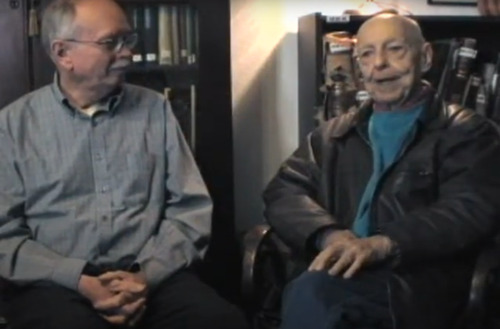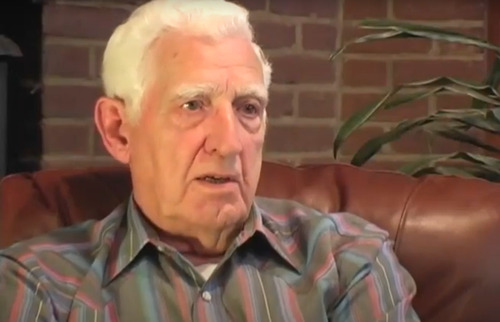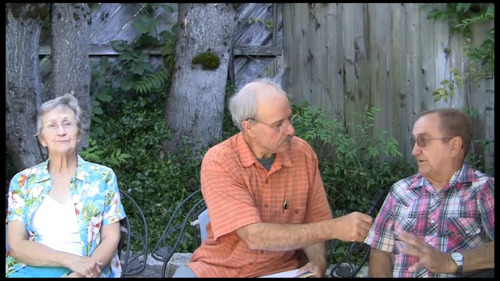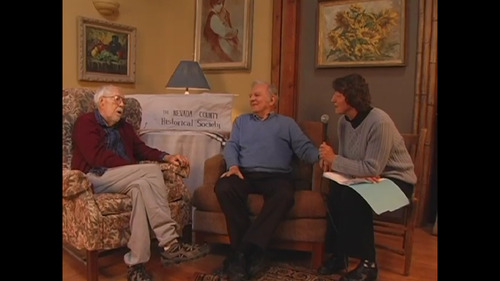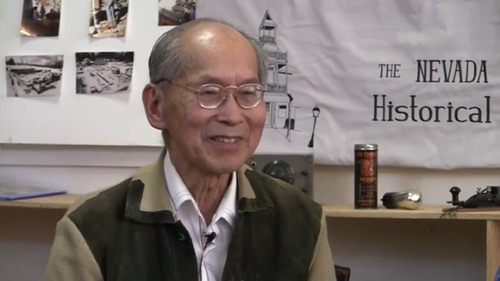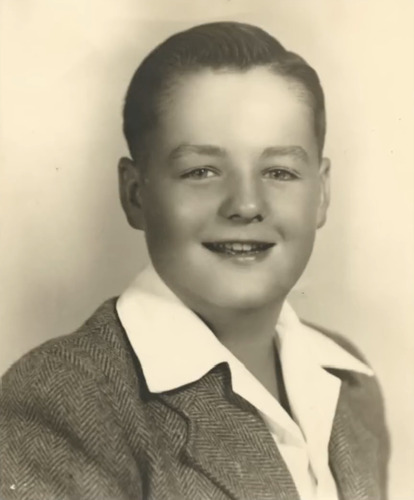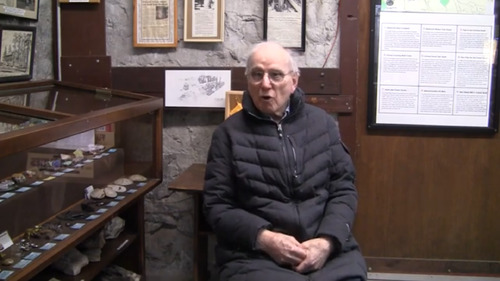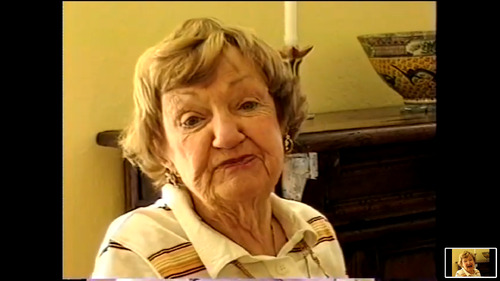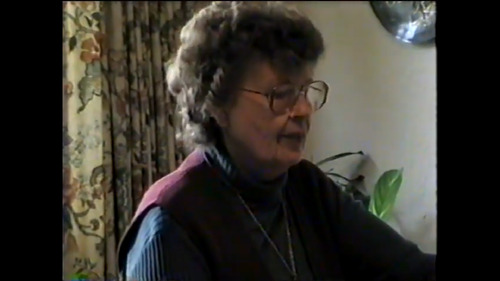Enter a name, company, place or keywords to search across the Nevada County Historical Archive's thousands of pages of online items and thousands of index records. Then click "Search" (or hit Enter).
All Items > Videos > Oral Histories > Finding Guide
Finding Guide for "Oral Histories" (24 images in 15 items)
Ardis Comstock Interview
In this interview Ardis Comstock recounts her life story, focusing on her family's move to Nevada County, California during the Depression and the subsequent mining boom. Her father, a skilled carpenter and contractor, became highly sought-after for building homes for the influx of miners. Ardis describes her experiences attending school in a one-room schoolhouse, working at Douglas Aircraft during WWII, and her involvement with the Black Panthers through her husband David. She also details her family history, including her mother's immigration from Germany and her grandparents' lives as farmers and railroad workers. Throughout the interview, Ardis shares anecdotes about notable figures in the community, such as Lyman Gilmour, and reflects on the changes she has witnessed in Nevada County over the years.
Created: May 14, 2025
# of Slides/Images: 1
Download PDF: User Login Required
User Login Required
Download OCR Text: User Login Required
User Login Required
Link: https://archive.nevadacountyhistory.org/search/?Id=17701
Created: May 14, 2025
# of Slides/Images: 1
Download PDF:
Download OCR Text:
Citation:
"Ardis Comstock Interview"
Oral Histories, May 14, 2025. Searls Historical Library, https://archive.nevadacountyhistory.org/search/?Id=17701
Oral Histories, May 14, 2025. Searls Historical Library, https://archive.nevadacountyhistory.org/search/?Id=17701
Link: https://archive.nevadacountyhistory.org/search/?Id=17701
David Comstock Interview
David Comstock, a Nevada County historian, shares his life story and passion for local history in this interview. He discusses his early life in Oakland and Walnut Creek, his time in the Air Force, and his career in commercial art and publishing. Comstock recounts how he met his wife, Artis, and their shared dream of building a self-sufficient life in the Nevada County woods. He details their efforts to construct their own home and the challenges they faced. Comstock's fascination with the area's rich history led him to extensive research, resulting in the publication of several books and historical indexes. He emphasizes the importance of preserving historical accuracy and shares his ongoing work organizing and publishing historical records. Comstock's dedication to local history is evident in his meticulous approach to research and his commitment to making historical information accessible to others.
Created: October 1, 2004
# of Slides/Images: 1
Download PDF: User Login Required
User Login Required
Download OCR Text: User Login Required
User Login Required
Link: https://archive.nevadacountyhistory.org/search/?Id=17702
Created: October 1, 2004
# of Slides/Images: 1
Download PDF:
Download OCR Text:
Citation:
"David Comstock Interview"
Oral Histories, October 1, 2004. Searls Historical Library, https://archive.nevadacountyhistory.org/search/?Id=17702
Oral Histories, October 1, 2004. Searls Historical Library, https://archive.nevadacountyhistory.org/search/?Id=17702
Link: https://archive.nevadacountyhistory.org/search/?Id=17702
Ed Hamilton Interview
In this interview, Ed Hamilton, born in 1907, recounts his life story, focusing on his diverse work experiences and his passion for music. He discusses his early life in Montana, working in copper mines and learning about mining techniques. After moving to California, he worked various jobs, including in the gold mines, before settling in Grass Valley. Hamilton describes building his own house while working long hours at the mine and later becoming involved in union activities. He shares his experiences working as a welder in shipyards during WWII and his return to Grass Valley after the war. Hamilton also talks about his ventures in the ready-mix concrete business and backhoe work, as well as his love for music and playing in bands throughout his life. The interview concludes with Hamilton reflecting on his health challenges and his contentment with his current living situation.
Created: July 1, 2006
# of Slides/Images: 1
Download PDF: User Login Required
User Login Required
Download OCR Text: User Login Required
User Login Required
Link: https://archive.nevadacountyhistory.org/search/?Id=17703
Created: July 1, 2006
# of Slides/Images: 1
Download PDF:
Download OCR Text:
Citation:
"Ed Hamilton Interview"
Oral Histories, July 1, 2006. Searls Historical Library, https://archive.nevadacountyhistory.org/search/?Id=17703
Oral Histories, July 1, 2006. Searls Historical Library, https://archive.nevadacountyhistory.org/search/?Id=17703
Link: https://archive.nevadacountyhistory.org/search/?Id=17703
Ed Yun Interview
Ed Yun, a long-time resident of Grass Valley, California, shared his life story in an interview with the Nevada County Historical Society. He recounted his family's move to Grass Valley from San Francisco when he was 14 years old, and his experiences attending local schools and adjusting to a new community. Ed's father opened a grocery store, which later expanded to include a meat market, and Ed played a vital role in helping run the family business. He shared anecdotes about his school days, his passion for fishing, and the diverse community of Grass Valley, which included Cornish miners, Chinese immigrants, Italian restaurateurs, and lumberjacks from Oklahoma and Arkansas. After graduating from high school, Ed attended Sacramento Junior College and then enlisted in the army during World War II. He served in India and was stationed in a finance office due to his business background. After the war, he attended UC Berkeley, where he met his wife Alice. The couple returned to Grass Valley, where they raised three children and remained active in the community. Ed's interview provides a valuable glimpse into the history of Grass Valley and the experiences of a Chinese immigrant family in the mid-20th century.
# of Slides/Images: 2
Download PDF: User Login Required
User Login Required
Download OCR Text: User Login Required
User Login Required
Link: https://archive.nevadacountyhistory.org/search/?Id=17704
# of Slides/Images: 2
Download PDF:
Download OCR Text:
Citation:
"Ed Yun Interview"
Oral Histories. Searls Historical Library, https://archive.nevadacountyhistory.org/search/?Id=17704
Oral Histories. Searls Historical Library, https://archive.nevadacountyhistory.org/search/?Id=17704
Link: https://archive.nevadacountyhistory.org/search/?Id=17704
Edwin Tyson Interview, Curator of the Searls Library
This video interview was recorded in the last days of Edwin Tyson, curator of the Searls Library and revered Nevada County historian and resident of Nevada City for many years. He became synonymous with the Searls Library to the extent that tourists sometimes assumed he was "old Mr. Searls." Ed passed away, at age 92 in February 2010, shortly after recording this oral history. He was much respected and beloved. In this interview, Ed shares his journey of becoming a central figure at the Searls Library. He began volunteering one afternoon a week and gradually took on more responsibilities, eventually being left in charge during a two-week leave. Tyson's dedication and the library's struggle for independence led to a more permanent role, where he even worked six days a week during a challenging period. He opposed the library being taken over by the county library system, emphasizing the importance of autonomy and the historical significance of the Searls family. Tyson's personal history, including his Midwestern upbringing, academic pursuits in psychology and English, and a serendipitous move to California, all contributed to his deep-rooted connection to the Searls Library. His story reflects his passion for libraries and his commitment to preserving the legacy of the Searls Library. Wally Hagaman conducted the interview at the Searls Library.
Created: May 14, 2025
# of Slides/Images: 1
Download PDF: User Login Required
User Login Required
Download OCR Text: User Login Required
User Login Required
Link: https://archive.nevadacountyhistory.org/search/?Id=17705
Created: May 14, 2025
# of Slides/Images: 1
Download PDF:
Download OCR Text:
Citation:
"Edwin Tyson Interview, Curator of the Searls Library"
Oral Histories, May 14, 2025. Searls Historical Library, https://archive.nevadacountyhistory.org/search/?Id=17705
Oral Histories, May 14, 2025. Searls Historical Library, https://archive.nevadacountyhistory.org/search/?Id=17705
Link: https://archive.nevadacountyhistory.org/search/?Id=17705
Glenn Jones Interview
Glenn Jones, born in Nevada City in 1924, recounts his lifelong experiences in Grass Valley, California, with a focus on the region's mining history and the changing local industries. He describes attending school and working various jobs as a young boy, including delivering newspapers and working in a bakery and butcher shop. He recalls the lack of refrigeration and the delivery of ice and vegetables by Chinese immigrants, highlighting the significant presence of a Chinese community in the area. He then discusses his experiences working in the family hardware business, which had been established in 1854 and remained in the family for over 110 years. He details the construction of the fireproof hardware store building, emphasizing the necessity of such measures due to frequent fires in early towns. He also shares his memories of working in various industries during WWII, including construction, carpentry, and glazing, and his subsequent service in the Navy as a gunner's mate. He reflects on the challenges and rewards of his time in the Navy, particularly his extensive travels throughout Alaska. The interview also covers his involvement in the creation of the local mining exhibit, his insights into the realities of high-grading in the mines, and his recollections of harsh winters and the community's resilience in the face of heavy snowfall and limited resources.
Created: June 18, 2004
# of Slides/Images: 1
Download PDF: User Login Required
User Login Required
Download OCR Text: User Login Required
User Login Required
Link: https://archive.nevadacountyhistory.org/search/?Id=17706
Created: June 18, 2004
# of Slides/Images: 1
Download PDF:
Download OCR Text:
Citation:
"Glenn Jones Interview"
Oral Histories, June 18, 2004. Searls Historical Library, https://archive.nevadacountyhistory.org/search/?Id=17706
Oral Histories, June 18, 2004. Searls Historical Library, https://archive.nevadacountyhistory.org/search/?Id=17706
Link: https://archive.nevadacountyhistory.org/search/?Id=17706
Jack Clark Interview Part 2
This video tape (part 2 only) was provided by Phil Carville of the South Yuba Club. He managed the Loma Rica Ranch from 2002 to 2008 and interviewed Jack Clark about the history of the ranch. The video is an interview with Jack Clark, a former employee of the Idaho Maryland Mine. He discusses the working conditions in the mine, including the temperature, humidity, and airflow. He explains how the mine was ventilated using a combination of natural airflow and fans. He also describes the buddy system used to ensure the safety of the miners, and the role of shift bosses in overseeing the work. He recounts a personal experience of fear while mapping a stope alone in the mine. The interview touches on the impact of World War II on the mine's workforce, with many men opting for better-paying jobs in defense plants or logging. The interviewee shares his impression of Errol McBoyle, a well-respected manager of the mine. The conversation then turns to the history of Lake Olympia, a popular recreational area that was eventually closed due to pollution. Finally, he discusses the closure of the Idaho Maryland Mine in the 1950s and the challenges posed by the rising cost of gold mining.
Created: February 14, 2005
# of Slides/Images: 1
Download PDF: User Login Required
User Login Required
Download OCR Text: User Login Required
User Login Required
Link: https://archive.nevadacountyhistory.org/search/?Id=17707
Created: February 14, 2005
# of Slides/Images: 1
Download PDF:
Download OCR Text:
Citation:
"Jack Clark Interview Part 2"
Oral Histories, February 14, 2005. Searls Historical Library, https://archive.nevadacountyhistory.org/search/?Id=17707
Oral Histories, February 14, 2005. Searls Historical Library, https://archive.nevadacountyhistory.org/search/?Id=17707
Link: https://archive.nevadacountyhistory.org/search/?Id=17707
Marian & Darrell Murphy Interview
In an oral history interview conducted by the Nevada County Historical Society, siblings Marion Murphy Jewett and Darrell Murphy shared their family's deep-rooted connection to Grass Valley, California. Their grandparents and father emigrated from Canada in the early 20th century, drawn by the region's mining industry. Darrell recounted his father's experiences working as a relief hoistman at the Empire and Pennsylvania mines, emphasizing the close-knit community of miners and their families. Marion shared her memories of growing up in the area, attending Union Hill School, and participating in community activities. She spoke fondly of her time as a nurse at Weimar Medical Center, a former tuberculosis sanatorium that later became a general hospital. Both siblings highlighted the importance of community service, with Darrell discussing his involvement in disaster relief efforts and the Hospitality House, a local homeless shelter. Marion shared the history of the Grass Valley Ladies Relief Society, a charitable organization founded in 1873 to support struggling families in the community. The interview concluded with a reflection on the changes Grass Valley has undergone over the years, as the once-thriving mining town transitioned into a popular destination for newcomers seeking a quieter lifestyle. Despite these changes, the Murphy siblings expressed their enduring love for the community and their commitment to preserving its rich history.
# of Slides/Images: 1
Download PDF: User Login Required
User Login Required
Download OCR Text: User Login Required
User Login Required
Link: https://archive.nevadacountyhistory.org/search/?Id=17708
# of Slides/Images: 1
Download PDF:
Download OCR Text:
Citation:
"Marian & Darrell Murphy Interview"
Oral Histories. Searls Historical Library, https://archive.nevadacountyhistory.org/search/?Id=17708
Oral Histories. Searls Historical Library, https://archive.nevadacountyhistory.org/search/?Id=17708
Link: https://archive.nevadacountyhistory.org/search/?Id=17708
Mike Nevius Interview
In an interview with the Nevada County Historical Society, Mike Nevis, a collector and preservationist, shared his life story and experiences growing up in Nevada County during the 1940s and 50s. He recounted his father's purchase of a Union Hill store in 1949, a time of economic prosperity fueled by the mining industry. Mike helped out in the store, doing odd jobs and occasionally cooking for the school children who frequented the store. However, the closure of the mines in 1957 led to unpaid debts from miners, ultimately causing his father to lose the store. Mike's passion for mechanics blossomed at a young age, and he fondly remembered his first car, a 28 model A cabriolet, which he purchased at 13 and learned to repair with his father's guidance. After the store's closure, Mike's family moved to Susanville, where he finished high school and met his wife, Levita. Despite enjoying his time in Susanville, Mike yearned to return to Nevada County, and eventually secured a job with the Forest Service, allowing him and Levita to settle back in the area. Throughout his life, Mike maintained a deep fascination with the local mining history, collecting artifacts and exploring abandoned mines. He shared anecdotes about high-graders, miners who stole gold from the companies, and his own experiences panning for gold and even trading it for goods and services. Mike's dedication to preserving the region's mining heritage led him to amass an extensive collection of artifacts, which he generously shared with the community through tours and educational programs. He emphasized the importance of preserving this history for future generations, highlighting the ingenuity and resourcefulness of the miners who played a crucial role in shaping the community's development.
# of Slides/Images: 1
Download PDF: User Login Required
User Login Required
Download OCR Text: User Login Required
User Login Required
Link: https://archive.nevadacountyhistory.org/search/?Id=17709
# of Slides/Images: 1
Download PDF:
Download OCR Text:
Citation:
"Mike Nevius Interview"
Oral Histories. Searls Historical Library, https://archive.nevadacountyhistory.org/search/?Id=17709
Oral Histories. Searls Historical Library, https://archive.nevadacountyhistory.org/search/?Id=17709
Link: https://archive.nevadacountyhistory.org/search/?Id=17709
Nevada City Historical District Ordinance 338 with Beryl Robinson & Bill Wetherall
Presenter: Cathy Wilcox-Barnes, Beryl Robinson, Bill Wetherall
In a 2013 Nevada County Historical Society oral history interview [conducted by Cathy Wilcox-Barnes], former Nevada City attorney Bill Wetherall and former city manager Beryl P. Robinson, Jr. discussed the creation and impact of the city's historic district ordinance. The ordinance, crafted by Wetherall in 1968, [established an Historical District in the commercial quarter of the city, in which it] aimed to preserve the city's unique [Motherlode] architectural character and prevent uncontrolled development. The decision to create a historic district was spurred by concerns over the demolition of several significant buildings and a desire to protect the city's heritage. Wetherall and Robinson recounted the challenges faced during the ordinance's development, including economic difficulties and opposition from some community members. However, the ordinance ultimately proved successful, contributing to the preservation of Nevada City's historic charm and boosting property values. The interview highlighted the importance of the ordinance in shaping the city's identity and ensuring its long-term economic and cultural vitality.
Wetherall and Robinson
William Bascom Wetherall (1911-2013) and Beryl Robinson Jr. (1937-2023) worked closely together, with others, to create the storied Historical District Ordinance, unanimously passed by the Nevada City City Council on Monday, 12 August 1968. The formal title of Ordinance No. 338 is "AN ORDINANCE OF THE CITY OF NEVADA CITY ESTABLISHING AN HISTORICAL DISTRICT AND PROVIDING REGULATIONS FOR THE PROTECTION, ENHANCEMENT AND PERPETUATION OF BUILDINGS THEREIN". The ordinance went into effect 30 days after its passage.
Wetherall, Nevada City City Attorney for 20 years (1959-1979), turned 102 years old 3 weeks and died 3 months after this 3 March 2013 interview. At the time he turned 100, he was the oldest still practicing attorney in California. He is the namesake of the Wetherall Conference Room in Nevada City City Hall on Broad street.
Robinson, a Nevada City council member for 1 year (1964-1965), then the City Manager for 37 years (1965-2002), died 10 years later at the age of 87. On 13 November 1998, while he was still incumbant, the City Council named the park at the foot of Main street, near Ott's Assay Office and the South Yuba Canal Building, Robinson Plaza. On 16 September 1999, the council placed a bronze plaque in the plaza, commemorating Robinson, who that year had become the longest serving city manager in California history (the record has since been broken).
See Nevada City Historical District Ordinance 338 for the following three documents.
1. The original ordinance as passed on 12 August 1968 (7 pages plus map)
2. "The story of the Nevada City historical ordinance", a typescript report by
William B. Wetherall signed 30 September 1996 (13 pages)
3. "Nevada City gets historical endorsement", a 2 August 1985 article in The Union by Tom Nadea,
on the endorsement by California State Historical Resources Commission of Nevada City's
application for inclusion of downtown Nevada City in the National Historical Register
Wetherall's report is also reproduced in Nevada County Historical Society Bulletin, Volume 51, Number 1, January 1997 (pages 2-5).
About Cathy Wilcox-Barnes, Beryl Robinson, Bill Wetherall: Ordinance No. 338 is entitled "AN ORDINANCE OF THE CITY OF NEVADA CITY ESTABLISHING AN HISTORICAL DISTRICT AND PROVIDING REGULATIONS FOR THE PROTECTION, ENHANCEMENT AND PERPETUATION OF BUILDINGS THEREIN". The ordinance was adopted by Nevada City City Council on 12 August 1968. The council was composed of Mayor John Rankin and council members Arch McPherson, Lon Cooper, Bob Paine, and Joe Day, and the vote was unanimous.
Related Items:
Created: March 3, 2013
Subjects: Nevada City, Historical District, Historical Ordinance, Ordinance No. 338, 12 August 1968
Source(s): NCHS produced oral history interview.
# of Slides/Images: 4
Download PDF: User Login Required
User Login Required
Download OCR Text: User Login Required
User Login Required
Link: https://archive.nevadacountyhistory.org/search/?Id=1823
In a 2013 Nevada County Historical Society oral history interview [conducted by Cathy Wilcox-Barnes], former Nevada City attorney Bill Wetherall and former city manager Beryl P. Robinson, Jr. discussed the creation and impact of the city's historic district ordinance. The ordinance, crafted by Wetherall in 1968, [established an Historical District in the commercial quarter of the city, in which it] aimed to preserve the city's unique [Motherlode] architectural character and prevent uncontrolled development. The decision to create a historic district was spurred by concerns over the demolition of several significant buildings and a desire to protect the city's heritage. Wetherall and Robinson recounted the challenges faced during the ordinance's development, including economic difficulties and opposition from some community members. However, the ordinance ultimately proved successful, contributing to the preservation of Nevada City's historic charm and boosting property values. The interview highlighted the importance of the ordinance in shaping the city's identity and ensuring its long-term economic and cultural vitality.
Wetherall and Robinson
William Bascom Wetherall (1911-2013) and Beryl Robinson Jr. (1937-2023) worked closely together, with others, to create the storied Historical District Ordinance, unanimously passed by the Nevada City City Council on Monday, 12 August 1968. The formal title of Ordinance No. 338 is "AN ORDINANCE OF THE CITY OF NEVADA CITY ESTABLISHING AN HISTORICAL DISTRICT AND PROVIDING REGULATIONS FOR THE PROTECTION, ENHANCEMENT AND PERPETUATION OF BUILDINGS THEREIN". The ordinance went into effect 30 days after its passage.
Wetherall, Nevada City City Attorney for 20 years (1959-1979), turned 102 years old 3 weeks and died 3 months after this 3 March 2013 interview. At the time he turned 100, he was the oldest still practicing attorney in California. He is the namesake of the Wetherall Conference Room in Nevada City City Hall on Broad street.
Robinson, a Nevada City council member for 1 year (1964-1965), then the City Manager for 37 years (1965-2002), died 10 years later at the age of 87. On 13 November 1998, while he was still incumbant, the City Council named the park at the foot of Main street, near Ott's Assay Office and the South Yuba Canal Building, Robinson Plaza. On 16 September 1999, the council placed a bronze plaque in the plaza, commemorating Robinson, who that year had become the longest serving city manager in California history (the record has since been broken).
See Nevada City Historical District Ordinance 338 for the following three documents.
1. The original ordinance as passed on 12 August 1968 (7 pages plus map)
2. "The story of the Nevada City historical ordinance", a typescript report by
William B. Wetherall signed 30 September 1996 (13 pages)
3. "Nevada City gets historical endorsement", a 2 August 1985 article in The Union by Tom Nadea,
on the endorsement by California State Historical Resources Commission of Nevada City's
application for inclusion of downtown Nevada City in the National Historical Register
Wetherall's report is also reproduced in Nevada County Historical Society Bulletin, Volume 51, Number 1, January 1997 (pages 2-5).
About Cathy Wilcox-Barnes, Beryl Robinson, Bill Wetherall: Ordinance No. 338 is entitled "AN ORDINANCE OF THE CITY OF NEVADA CITY ESTABLISHING AN HISTORICAL DISTRICT AND PROVIDING REGULATIONS FOR THE PROTECTION, ENHANCEMENT AND PERPETUATION OF BUILDINGS THEREIN". The ordinance was adopted by Nevada City City Council on 12 August 1968. The council was composed of Mayor John Rankin and council members Arch McPherson, Lon Cooper, Bob Paine, and Joe Day, and the vote was unanimous.
Related Items:
- Nevada City Historical District Ordinance 338 (Uncataloged)(1968, 1985, 1996)
- Nevada County Historical Society Bulletins > Volume 051-1 - January 1997
Created: March 3, 2013
Subjects: Nevada City, Historical District, Historical Ordinance, Ordinance No. 338, 12 August 1968
Source(s): NCHS produced oral history interview.
# of Slides/Images: 4
Download PDF:
Download OCR Text:
Citation:
Cathy Wilcox-Barnes, Beryl Robinson, Bill Wetherall. "Nevada City Historical District Ordinance 338 with Beryl Robinson & Bill Wetherall"
Oral Histories, March 3, 2013. Searls Historical Library, https://archive.nevadacountyhistory.org/search/?Id=1823
Oral Histories, March 3, 2013. Searls Historical Library, https://archive.nevadacountyhistory.org/search/?Id=1823
Link: https://archive.nevadacountyhistory.org/search/?Id=1823
Oral History with Phil Oyung
Phil Oyang, born in 1938, recounts his family history and experiences growing up in a cabin behind the Empire Mill in Grass Valley, California. His grandparents immigrated from China around the turn of the century and worked for the mine owners. Phil's father arrived in 1916, followed by his mother in 1924. The family cabin, initially a one-room dwelling, was gradually expanded to accommodate their growing family. Phil describes the close-knit community and the challenges of life in a mining town, including the risks associated with mining work and the prevalence of high-grading. He also shares anecdotes about his family's interactions with the mine owners and the local community, highlighting the unique cultural blend of Chinese traditions and American life. Phil's stories offer a personal perspective on the history of the Empire Mine and the people who lived and worked there.
Created: January 14, 2013
# of Slides/Images: 1
Download PDF: User Login Required
User Login Required
Download OCR Text: User Login Required
User Login Required
Link: https://archive.nevadacountyhistory.org/search/?Id=17710
Created: January 14, 2013
# of Slides/Images: 1
Download PDF:
Download OCR Text:
Citation:
"Oral History with Phil Oyung"
Oral Histories, January 14, 2013. Searls Historical Library, https://archive.nevadacountyhistory.org/search/?Id=17710
Oral Histories, January 14, 2013. Searls Historical Library, https://archive.nevadacountyhistory.org/search/?Id=17710
Link: https://archive.nevadacountyhistory.org/search/?Id=17710
Orlo Steele & Gerald Angove Interview
In an interview with the Nevada County Historical Society, Orlo Steele and Gerald Angove, two long-time residents of Grass Valley, shared their experiences growing up in the area during the 1940s and 50s. They discussed the strong Cornish influence in the community, with many families, including their own, having emigrated from Cornwall to work in the mines. The closure of the mines during World War II led to economic hardship and prompted Orlo's father to open a retail store. Both Orlo and Gerald held various jobs throughout their youth, including caddying, setting pins at the bowling alley, and working in the mines. They also shared memories of their high school years, participating in sports, and the rivalry between Grass Valley and Nevada City high schools. After graduating, they both attended Stanford University, where they worked various jobs to support their education. Orlo worked as a mucker in the Empire Mine, while Gerald worked as a hasher in a girl's dormitory. After completing their studies, they pursued successful careers, with Orlo working for the FAA and Gerald serving as the president of Sierra College. Despite their travels, they both felt a strong connection to their hometown and eventually returned to Grass Valley. They expressed their appreciation for the community's growth and development, highlighting the positive changes that have taken place over the years.
Created: August 8, 2012
# of Slides/Images: 5
Download PDF: User Login Required
User Login Required
Download OCR Text: User Login Required
User Login Required
Link: https://archive.nevadacountyhistory.org/search/?Id=17711
Created: August 8, 2012
# of Slides/Images: 5
Download PDF:
Download OCR Text:
Citation:
"Orlo Steele & Gerald Angove Interview"
Oral Histories, August 8, 2012. Searls Historical Library, https://archive.nevadacountyhistory.org/search/?Id=17711
Oral Histories, August 8, 2012. Searls Historical Library, https://archive.nevadacountyhistory.org/search/?Id=17711
Link: https://archive.nevadacountyhistory.org/search/?Id=17711
Rolf Laessig Mining Museum Oral History
Rolf Laessig, interviewed by Gary Kisor, recounts his time restoring mining equipment at the North Star Mining Museum in Grass Valley, California. Laessig began his work under Rudy Caesar, focusing on restoring a dynamite packing machine and a steam donkey. He emphasizes the challenges of working without plans or drawings, relying on ingenuity and problem-solving skills. Laessig also discusses his collaborations with other individuals, including Bob Shoemaker and Perry, a skilled carpenter. The conversation touches on various restored machines, their origins, and the intricacies of their mechanisms. Laessig's dedication to preserving the museum's artifacts and his passion for mechanical restoration are evident throughout the interview. The transcript also includes a brief exchange about the museum's history and the contributions of figures like Glenn Jones.
Created: April 15, 2024
# of Slides/Images: 1
Download PDF: User Login Required
User Login Required
Download OCR Text: User Login Required
User Login Required
Link: https://archive.nevadacountyhistory.org/search/?Id=17712
Created: April 15, 2024
# of Slides/Images: 1
Download PDF:
Download OCR Text:
Citation:
"Rolf Laessig Mining Museum Oral History"
Oral Histories, April 15, 2024. Searls Historical Library, https://archive.nevadacountyhistory.org/search/?Id=17712
Oral Histories, April 15, 2024. Searls Historical Library, https://archive.nevadacountyhistory.org/search/?Id=17712
Link: https://archive.nevadacountyhistory.org/search/?Id=17712
Ruth Tremoreux Interview at 403 Neal St, Grass Valley
Ruth Tremoreux, born in Nevada City, California in 1916, shares her life story and memories of growing up in the area. She recalls attending local schools, the rivalry between Nevada City and Grass Valley, and the burning down of her high school. After graduating, she pursued a teaching career, influenced by her father's wishes for her to have a profession. Tremoreux taught in various locations, including Calistoga and Grass Valley, before getting married and moving to San Francisco. She describes her family life, including her two daughters and their children. Tremoreux also delves into her family history, mentioning her parents and grandparents who were prominent figures in Nevada City. She recounts her childhood experiences living on Nevada Street, her interactions with local families like the Fults and the Laws, and her memories of the mining industry's impact on the region. Throughout the interview, Tremoreux reflects on the changes she has witnessed in Nevada City and Grass Valley over the years, offering a personal perspective on the area's history and development.
Created: June 26, 2004
# of Slides/Images: 1
Download PDF: User Login Required
User Login Required
Download OCR Text: User Login Required
User Login Required
Link: https://archive.nevadacountyhistory.org/search/?Id=17713
Created: June 26, 2004
# of Slides/Images: 1
Download PDF:
Download OCR Text:
Citation:
"Ruth Tremoreux Interview at 403 Neal St, Grass Valley"
Oral Histories, June 26, 2004. Searls Historical Library, https://archive.nevadacountyhistory.org/search/?Id=17713
Oral Histories, June 26, 2004. Searls Historical Library, https://archive.nevadacountyhistory.org/search/?Id=17713
Link: https://archive.nevadacountyhistory.org/search/?Id=17713
Vinnie & Genevieve Ingram Interview
This interview discusses the Ingram family and their deep roots in Grass Valley, California. Vinnie Ingram (née Beck) recounts her family history, her marriage to Maris Ingram, and their sons' careers in journalism. She also shares anecdotes about her husband's family, including his father, a state senator who was highly respected in the community. The conversation touches on various aspects of life in Grass Valley, including changes over time, the impact of the mining industry, and the importance of community involvement. Genevieve Ingram, Vinnie's niece by marriage, adds her perspective on growing up in Nevada City, a neighboring town. The interview offers a glimpse into the lives of two women connected by family and their shared experiences in this historic region of California.
Created: January 28, 2005
# of Slides/Images: 2
Download PDF: User Login Required
User Login Required
Download OCR Text: User Login Required
User Login Required
Link: https://archive.nevadacountyhistory.org/search/?Id=17714
Created: January 28, 2005
# of Slides/Images: 2
Download PDF:
Download OCR Text:
Citation:
"Vinnie & Genevieve Ingram Interview"
Oral Histories, January 28, 2005. Searls Historical Library, https://archive.nevadacountyhistory.org/search/?Id=17714
Oral Histories, January 28, 2005. Searls Historical Library, https://archive.nevadacountyhistory.org/search/?Id=17714
Link: https://archive.nevadacountyhistory.org/search/?Id=17714




